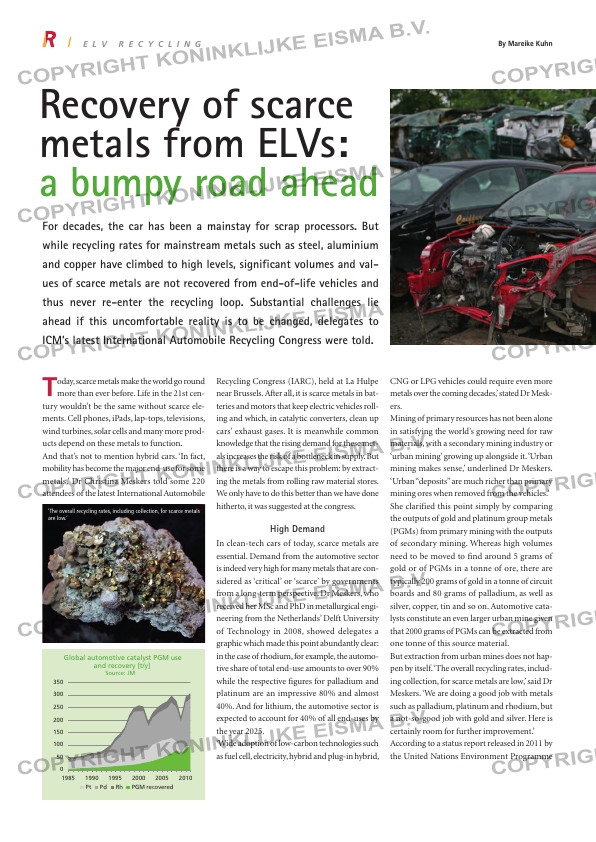Page 22 from: April 2013

Today, scarce metals make the world go round more than ever before. Life in the 21st cen-
tury wouldn’t be the same without scarce ele-
ments. Cell phones, iPads, lap-tops, televisions,
wind turbines, solar cells and many more prod-
ucts depend on these metals to function.
And that’s not to mention hybrid cars. ‘In fact,
mobility has become the major end-use for some
metals,’ Dr Christina Meskers told some 220
attendees of the latest International Automobile
Recycling Congress (IARC), held at La Hulpe
near Brussels. After all, it is scarce metals in bat-
teries and motors that keep electric vehicles roll-
ing and which, in catalytic converters, clean up
cars’ exhaust gases. It is meanwhile common
knowledge that the rising demand for these met-
als increases the risk of a bottleneck in supply. But
there is a way to escape this problem: by extract-
ing the metals from rolling raw material stores.
We only have to do this better than we have done
hitherto, it was suggested at the congress.
High Demand
In clean-tech cars of today, scarce metals are
essential. Demand from the automotive sector
is indeed very high for many metals that are con-
sidered as ‘critical’ or ‘scarce’ by governments
from a long-term perspective. Dr Meskers, who
received her MSc and PhD in metallurgical engi-
neering from the Netherlands’ Delft University
of Technology in 2008, showed delegates a
graphic which made this point abundantly clear:
in the case of rhodium, for example, the automo-
tive share of total end-use amounts to over 90%
while the respective figures for palladium and
platinum are an impressive 80% and almost
40%. And for lithium, the automotive sector is
expected to account for 40% of all end-uses by
the year 2025.
‘Wide adoption of low-carbon technologies such
as fuel cell, electricity, hybrid and plug-in hybrid,
CNG or LPG vehicles could require even more
metals over the coming decades,’ stated Dr Mesk-
ers.
Mining of primary resources has not been alone
in satisfying the world’s growing need for raw
materials, with a secondary mining industry or
‘urban mining’ growing up alongside it. ‘Urban
mining makes sense,’ underlined Dr Meskers.
‘Urban “deposits” are much richer than primary
mining ores when removed from the vehicles.’
She clarified this point simply by comparing
the outputs of gold and platinum group metals
(PGMs) from primary mining with the outputs
of secondary mining. Whereas high volumes
need to be moved to find around 5 grams of
gold or of PGMs in a tonne of ore, there are
typically 200 grams of gold in a tonne of circuit
boards and 80 grams of palladium, as well as
silver, copper, tin and so on. Automotive cata-
lysts constitute an even larger urban mine given
that 2000 grams of PGMs can be extracted from
one tonne of this source material.
But extraction from urban mines does not hap-
pen by itself. ‘The overall recycling rates, includ-
ing collection, for scarce metals are low,’ said Dr
Meskers. ‘We are doing a good job with metals
such as palladium, platinum and rhodium, but
a not-so-good job with gold and silver. Here is
certainly room for further improvement.’
According to a status report released in 2011 by
the United Nations Environment Programme
E L V r E c y c L i n g By Mareike Kuhn
For decades, the car has been a mainstay for scrap processors. But
while recycling rates for mainstream metals such as steel, aluminium
and copper have climbed to high levels, significant volumes and val-
ues of scarce metals are not recovered from end-of-life vehicles and
thus never re-enter the recycling loop. Substantial challenges lie
ahead if this uncomfortable reality is to be changed, delegates to
ICM’s latest International Automobile Recycling Congress were told.
Recovery of scarce
metals from ELVs:
a bumpy road ahead
0% 20% 40% 60% 80% 100%
Rh
Pd
Pb
Pt
REE
Al
Li
Car electronics and aux. motors not quantified (contain additional Pd & REE)
Share of automotive use in total end-use for some key automotive metals
2025
Sources: Pt, Pd, Rh (Johnson Matthey, 2011); Pb (ILZSG, 2011); REE (Du, 2011), Li (Signum Box, 2011)
0
50
100
150
200
250
300
350
1985 1990 1995 2000 2005 2010
Pt Pd Rh PGM recovered
Global automotive catalyst PGM use
and recovery [t/y]
Source: JM
Residues
Residues
Dissipation
Residues
Residues
Historic wastes
(tailings, landfills)
End-of-Life
Product
manufacture
Use
Natural resources
Metals, alloys& compounds
New
scrap
Raw materials production
Recyc
ling
from
industrial
materials
from
Concentrates
& ores
product
reuse
Based on: C.E.M. Meskers:
Coated magnesium, designed for sustainability?
PhD thesis Delft University of Technology, 2008
‘The overall recycling rates, including collection, for scarce metals
are low.’
RI-3_Automobile Recycling.indd 22 08-04-13 16:10



